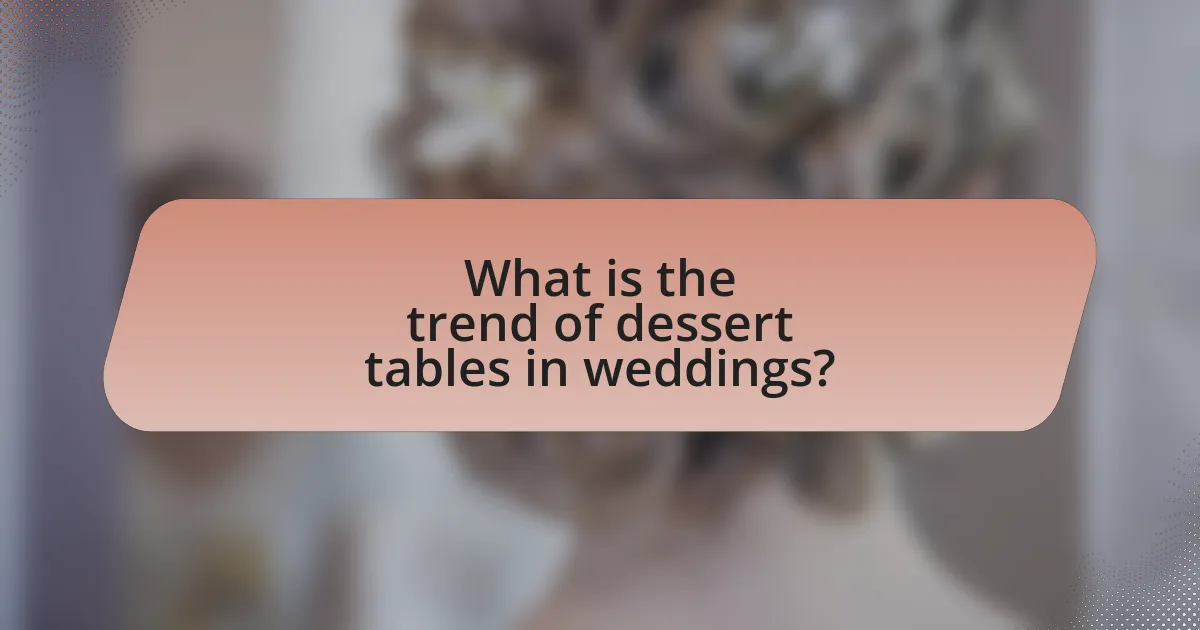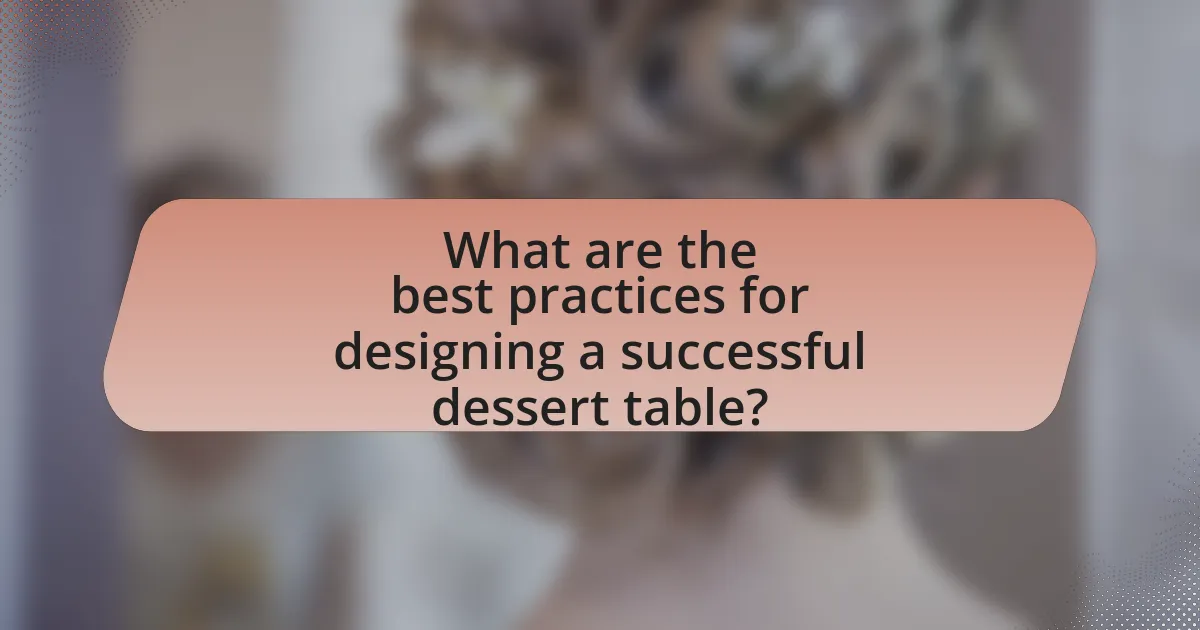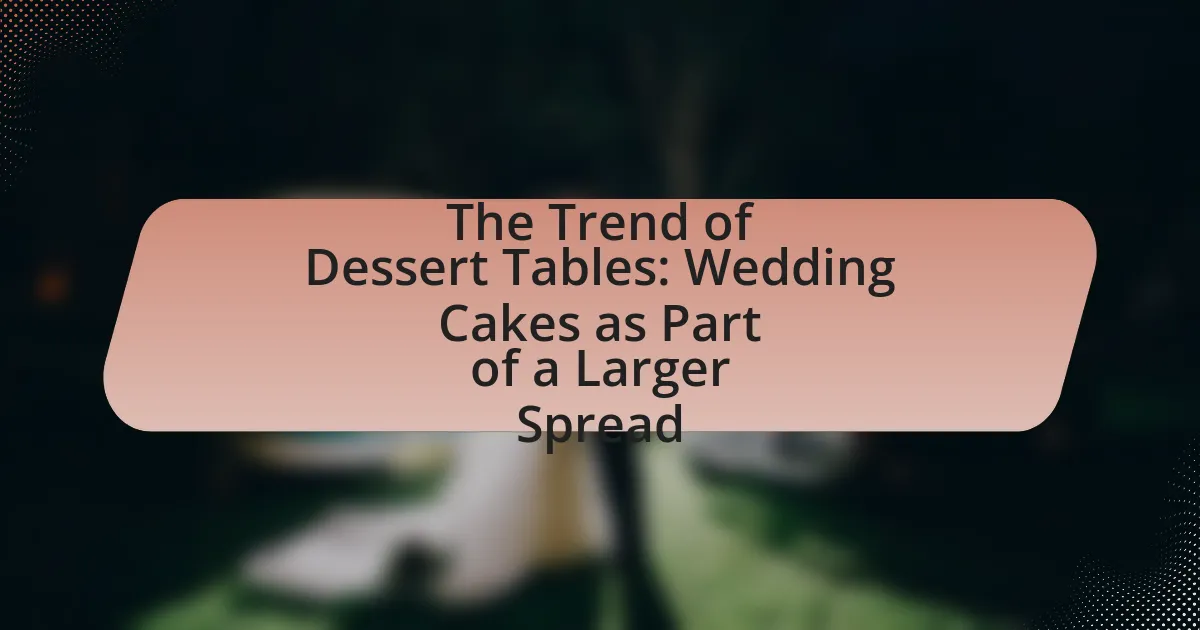The article examines the growing trend of dessert tables in weddings, highlighting their shift from traditional single wedding cakes to diverse displays featuring various sweets such as cupcakes, cookies, and themed desserts. It discusses how dessert tables enhance the wedding experience by providing a visually appealing selection that caters to different tastes and dietary restrictions, while also encouraging guest interaction. Key elements of successful dessert tables, including cohesive themes, presentation, and logistical considerations, are outlined, along with the enduring significance of wedding cakes within these displays. Additionally, the article explores popular design trends, cost implications, and best practices for creating memorable dessert experiences at weddings.

What is the trend of dessert tables in weddings?
The trend of dessert tables in weddings is increasingly popular as couples seek to create visually appealing and diverse dessert displays. This trend reflects a shift from traditional single wedding cakes to a variety of sweets, including cupcakes, cookies, and themed desserts, allowing for personalization and catering to different tastes. According to a survey by The Knot, 40% of couples in 2022 opted for dessert tables, highlighting their growing significance in modern wedding receptions. This trend not only enhances the aesthetic of the celebration but also provides guests with a broader selection of treats, making the dessert experience more interactive and enjoyable.
How have dessert tables evolved in modern weddings?
Dessert tables in modern weddings have evolved from traditional single wedding cakes to elaborate displays featuring a variety of sweets. This shift reflects changing guest preferences for diverse dessert options, allowing couples to personalize their celebrations. According to a survey by The Knot, 40% of couples now opt for dessert tables that include items like cupcakes, cookies, and macarons, catering to different tastes and dietary restrictions. This trend not only enhances the visual appeal of the wedding reception but also encourages interactive experiences, as guests can choose from a wider selection of treats.
What are the key elements of a dessert table?
The key elements of a dessert table include a variety of desserts, decorative elements, serving ware, and a cohesive theme. A variety of desserts ensures that there are options for different tastes, typically including cakes, pastries, cookies, and candies. Decorative elements, such as table linens, centerpieces, and signage, enhance the visual appeal and create an inviting atmosphere. Serving ware, including platters, stands, and utensils, is essential for presenting the desserts attractively and facilitating easy access for guests. A cohesive theme ties all these elements together, ensuring that the dessert table complements the overall event aesthetic, which is particularly important in settings like weddings where the dessert table is a focal point.
How do dessert tables enhance the wedding experience?
Dessert tables enhance the wedding experience by providing a visually appealing and diverse selection of sweets that cater to various tastes. This variety allows guests to choose from multiple options, increasing satisfaction and enjoyment during the celebration. Additionally, dessert tables serve as a focal point, encouraging social interaction among guests as they gather around to sample different treats. The presentation of these tables can be customized to match the wedding theme, adding to the overall aesthetic and ambiance of the event. Studies show that visually appealing food displays can enhance the dining experience, making dessert tables a strategic choice for creating memorable moments at weddings.
Why are wedding cakes still significant in dessert tables?
Wedding cakes remain significant in dessert tables because they symbolize tradition, celebration, and the couple’s unique identity. Historically, wedding cakes date back to ancient Rome, where they represented fertility and prosperity. In contemporary weddings, the cake serves as a focal point, often intricately designed to reflect the couple’s style and theme, enhancing the overall aesthetic of the dessert table. Additionally, the act of cutting the cake is a ceremonial moment that signifies the couple’s first act together as partners, reinforcing its importance in the wedding celebration.
What role does the wedding cake play in the overall dessert spread?
The wedding cake serves as the centerpiece of the overall dessert spread, symbolizing the couple’s union and often reflecting the wedding’s theme. Its prominent placement and design draw attention, making it a focal point for guests. Additionally, the wedding cake typically offers a variety of flavors and textures, complementing other desserts and enhancing the overall experience. According to a survey by The Knot, 78% of couples include a wedding cake in their dessert spread, highlighting its significance in wedding traditions and celebrations.
How do couples choose their wedding cake in relation to dessert tables?
Couples choose their wedding cake by considering its role within the overall dessert table spread. They often select a cake that complements the variety of desserts offered, ensuring visual harmony and flavor balance. For instance, if the dessert table features a range of flavors and styles, couples may opt for a wedding cake that either matches or contrasts these elements to create an appealing presentation. Additionally, couples frequently take into account dietary preferences and guest demographics when making their cake choice, ensuring that the cake aligns with the overall theme and offerings of the dessert table. This approach reflects a growing trend where the wedding cake is not just a standalone centerpiece but part of a cohesive dessert experience.
What are the popular trends in dessert table designs?
Popular trends in dessert table designs include the use of themed displays, interactive elements, and a focus on personalization. Themed displays often incorporate color schemes and motifs that align with the event’s overall aesthetic, enhancing visual appeal. Interactive elements, such as DIY stations for guests to create their own desserts, are increasingly popular, fostering engagement and enjoyment. Personalization, including custom desserts that reflect the couple’s tastes or significant moments, adds a unique touch that resonates with guests. These trends are supported by the growing demand for memorable and visually stunning experiences at events, as evidenced by social media platforms showcasing elaborate dessert tables.
How do color schemes and themes influence dessert table designs?
Color schemes and themes significantly influence dessert table designs by dictating the overall aesthetic and cohesion of the display. A well-chosen color palette enhances visual appeal, creates a harmonious atmosphere, and aligns with the event’s theme, such as a wedding or birthday celebration. For instance, a pastel color scheme can evoke a soft, romantic feel, while bold colors can create a vibrant, festive atmosphere. Research indicates that color psychology affects emotions and perceptions; for example, blue is often associated with calmness, while red can stimulate appetite. Therefore, selecting appropriate colors not only enhances the design but also impacts guests’ experiences and engagement with the dessert table.
What types of desserts are commonly included in dessert tables?
Dessert tables commonly include a variety of sweets such as cupcakes, cookies, brownies, and mini tarts. These desserts are often chosen for their visual appeal and ease of serving, making them ideal for events like weddings. Cupcakes can be decorated to match the event’s theme, while cookies and brownies provide a classic touch. Mini tarts offer a sophisticated option, often filled with fruits or creams. The inclusion of these desserts caters to diverse tastes and enhances the overall aesthetic of the dessert table, making it a focal point at celebrations.
How do dessert tables reflect personal style and preferences?
Dessert tables reflect personal style and preferences by showcasing a curated selection of sweets that align with individual tastes and themes. The variety of desserts, such as cakes, pastries, and candies, allows hosts to express their creativity and aesthetic choices, whether through color schemes, flavors, or presentation styles. For instance, a rustic wedding may feature homemade pies and artisanal treats, while a modern celebration might include sleek, minimalist desserts. This customization not only highlights the couple’s personality but also enhances the overall ambiance of the event, making it memorable for guests.
What are the logistical considerations for setting up a dessert table?
Logistical considerations for setting up a dessert table include space allocation, accessibility, and presentation. Space allocation is crucial as it determines how many desserts can be displayed and ensures guests can navigate around the table without obstruction. Accessibility involves placing the table in a location that is easy for guests to reach while considering traffic flow during the event. Presentation is important for aesthetic appeal and involves arranging desserts in an organized manner, using appropriate serving utensils and decorations to enhance visual impact. These factors collectively ensure that the dessert table is functional, inviting, and contributes positively to the overall event experience.

What are the benefits of incorporating dessert tables into weddings?
Incorporating dessert tables into weddings enhances the overall guest experience by providing a visually appealing and diverse selection of sweets. Dessert tables allow couples to showcase a variety of treats, catering to different tastes and dietary preferences, which can increase guest satisfaction. Additionally, they serve as a focal point for the reception, contributing to the decor and theme of the event. Research indicates that visually appealing food presentations can enhance enjoyment and create memorable experiences for guests, making dessert tables a strategic choice for modern weddings.
How do dessert tables cater to diverse guest preferences?
Dessert tables cater to diverse guest preferences by offering a variety of sweet options that accommodate different tastes, dietary restrictions, and cultural backgrounds. This variety includes gluten-free, vegan, and nut-free desserts, ensuring that all guests can find something enjoyable. For instance, a study by the National Confectioners Association indicates that 70% of consumers prefer a selection of desserts over a single option, highlighting the importance of variety in satisfying diverse palates. Additionally, incorporating traditional desserts from various cultures can enhance the guest experience by making them feel included and represented.
What types of dietary restrictions can be accommodated with dessert tables?
Dessert tables can accommodate various dietary restrictions, including gluten-free, dairy-free, vegan, nut-free, and sugar-free options. These accommodations are essential for ensuring that all guests can enjoy the offerings, as dietary restrictions affect a significant portion of the population; for instance, approximately 1 in 100 people have celiac disease, necessitating gluten-free options. Additionally, many individuals choose vegan or dairy-free diets for health or ethical reasons, making it crucial for dessert tables to include suitable selections. By providing a diverse range of desserts that cater to these restrictions, hosts can create an inclusive environment that enhances the overall experience for all attendees.
How do dessert tables create a more interactive experience for guests?
Dessert tables create a more interactive experience for guests by allowing them to choose from a variety of desserts, fostering engagement and social interaction. Guests can personalize their selections, which encourages them to explore different flavors and presentations, making the dessert experience more memorable. This setup often leads to conversations among guests as they discuss their choices and share recommendations, enhancing the overall social atmosphere of the event. Additionally, the visual appeal of a well-designed dessert table attracts attention and invites guests to participate, further increasing interaction.
What are the cost implications of dessert tables versus traditional wedding cakes?
Dessert tables generally have higher cost implications compared to traditional wedding cakes due to the variety and quantity of items included. While a traditional wedding cake typically ranges from $300 to $1,000 depending on size and design, dessert tables can cost between $500 and $2,500, as they often feature multiple dessert options like cupcakes, cookies, and pastries, which require more ingredients and labor. Additionally, dessert tables may necessitate more extensive setup and decoration, further increasing overall expenses.
How can couples budget effectively for dessert tables?
Couples can budget effectively for dessert tables by setting a clear budget limit, prioritizing their favorite desserts, and sourcing items from local bakeries or DIY options. Establishing a budget helps couples allocate funds appropriately, ensuring they do not overspend. Prioritizing favorite desserts allows couples to focus on what is most important to them, potentially reducing costs by limiting the variety. Sourcing from local bakeries can provide competitive pricing and fresh options, while DIY desserts can significantly cut costs, as evidenced by a study from The Knot, which found that couples who opted for DIY elements saved an average of 20% on their overall wedding budget.
What are some cost-saving tips for creating a dessert table?
To create a cost-effective dessert table, focus on selecting a few key desserts instead of a wide variety. This strategy reduces ingredient costs and simplifies preparation. Additionally, consider making desserts from scratch, as homemade items often cost less than store-bought alternatives. Utilizing seasonal fruits and ingredients can further lower expenses, as they are typically more affordable and fresher. Incorporating DIY elements, such as assembling desserts or creating simple decorations, can also save money while adding a personal touch. Finally, sourcing ingredients in bulk can lead to significant savings, especially for larger events.

What are the best practices for designing a successful dessert table?
The best practices for designing a successful dessert table include selecting a cohesive theme, ensuring variety in dessert types, and paying attention to presentation. A cohesive theme ties together the colors, styles, and types of desserts, creating a visually appealing display. Variety is essential as it caters to different tastes and dietary restrictions, including options like cakes, pastries, and gluten-free or vegan choices. Presentation matters significantly; using decorative stands, table linens, and appropriate lighting enhances the overall aesthetic. Research indicates that well-designed dessert tables can increase guest satisfaction and engagement at events, making these practices vital for success.
How can couples choose the right desserts for their table?
Couples can choose the right desserts for their table by considering their personal tastes, dietary restrictions, and the overall theme of their event. Personal preferences ensure that the desserts resonate with the couple’s style, while being mindful of dietary needs, such as allergies or vegan options, accommodates all guests. Additionally, aligning dessert choices with the event’s theme—whether rustic, elegant, or whimsical—creates a cohesive presentation. Research indicates that a well-curated dessert table enhances guest satisfaction and engagement, making it a memorable part of the celebration.
What factors should be considered when selecting dessert flavors?
When selecting dessert flavors, factors such as guest preferences, seasonal ingredients, dietary restrictions, and the overall theme of the event should be considered. Guest preferences are crucial, as understanding what flavors are popular among attendees can enhance enjoyment; for example, surveys or past event feedback can provide insights. Seasonal ingredients not only ensure freshness but also align with the time of year, such as using pumpkin in fall or berries in summer. Dietary restrictions, including allergies or specific diets like vegan or gluten-free, must be addressed to accommodate all guests, ensuring inclusivity. Lastly, the overall theme of the event influences flavor choices; for instance, a rustic wedding may favor flavors like chocolate and caramel, while a modern event might lean towards citrus or exotic flavors.
How can presentation enhance the appeal of a dessert table?
Presentation enhances the appeal of a dessert table by creating an inviting visual experience that attracts attention and stimulates appetite. A well-arranged dessert table, featuring varied heights, colors, and textures, can evoke emotions and encourage guests to indulge. Research indicates that visual aesthetics significantly influence food perception; for instance, a study published in the journal “Appetite” found that people are more likely to choose visually appealing food options over less attractive ones. Therefore, effective presentation not only showcases the desserts but also enhances their perceived value and desirability, making the dessert table a focal point of the event.
What are common mistakes to avoid when planning a dessert table?
Common mistakes to avoid when planning a dessert table include overloading the table with too many items, neglecting dietary restrictions, and failing to coordinate the dessert theme with the overall event. Overloading can lead to a cluttered appearance and overwhelm guests, while neglecting dietary restrictions may alienate some attendees, as 48% of people have specific dietary needs. Additionally, a lack of theme coordination can result in a disjointed presentation, diminishing the aesthetic appeal of the dessert table.
How can couples ensure they have enough desserts for their guests?
Couples can ensure they have enough desserts for their guests by calculating the appropriate quantity based on the number of attendees and the variety of desserts offered. A common guideline is to provide one to two servings of dessert per guest, depending on the event’s duration and the overall menu. For example, if a couple expects 100 guests, they should prepare between 100 to 200 dessert servings. Additionally, offering a diverse selection, such as cakes, pastries, and candies, can cater to different tastes and preferences, ensuring that all guests find something they enjoy. This approach is supported by event planning experts who recommend considering the type of event and the time of day when determining dessert quantities, as these factors influence guests’ appetites.
What should be done to maintain freshness and quality of desserts?
To maintain freshness and quality of desserts, proper storage techniques must be employed. Desserts should be stored in airtight containers to prevent moisture loss and contamination, which can lead to staleness or spoilage. Additionally, refrigeration is essential for perishable items like cream-based desserts, as it slows down bacterial growth and preserves texture. For optimal flavor, desserts should be consumed within a few days of preparation, as ingredients can degrade over time. Research indicates that maintaining a consistent temperature and humidity level can significantly extend the shelf life of baked goods, ensuring they remain appealing and safe to eat.
What are some creative ideas for unique dessert tables?
Unique dessert tables can feature a variety of creative ideas such as themed displays, interactive stations, and diverse dessert options. For instance, a vintage tea party theme can include an assortment of pastries, scones, and tea-infused desserts, while an interactive s’mores station allows guests to customize their treats with various toppings. Additionally, incorporating a mix of textures and flavors, such as chocolate fountains, fruit tarts, and mini cheesecakes, enhances visual appeal and caters to different tastes. The use of unique serving vessels, like wooden boards or glass cloches, can further elevate the presentation, making the dessert table a focal point at events.
How can seasonal themes influence dessert table choices?
Seasonal themes significantly influence dessert table choices by dictating the flavors, colors, and presentation styles that align with specific times of the year. For instance, autumn-themed dessert tables often feature flavors like pumpkin, apple, and spices, while spring-themed tables may highlight fresh fruits and floral designs. This alignment with seasonal ingredients not only enhances the aesthetic appeal but also ensures that the desserts are at their peak freshness and flavor, as seasonal produce is typically more abundant and flavorful. Additionally, seasonal themes can evoke certain emotions and memories, making the dessert table more memorable for guests, as seen in events where seasonal decorations and flavors create a cohesive experience.
What are some trending dessert options for modern weddings?
Trending dessert options for modern weddings include mini desserts, gourmet doughnuts, and dessert tables featuring a variety of sweets. Mini desserts, such as bite-sized cheesecakes and macarons, allow guests to sample multiple flavors without feeling overwhelmed. Gourmet doughnuts have gained popularity as a fun and customizable alternative to traditional wedding cakes, often displayed in creative arrangements. Additionally, dessert tables that showcase an assortment of treats, including cookies, cupcakes, and artisanal chocolates, provide a visually appealing and interactive experience for guests. This trend reflects a shift towards personalization and variety in wedding celebrations, catering to diverse tastes and preferences.
What tips can help couples create a memorable dessert table experience?
Couples can create a memorable dessert table experience by focusing on a cohesive theme, selecting a variety of desserts, and incorporating personal touches. A cohesive theme, such as a color palette or style that matches the wedding decor, enhances visual appeal and creates a unified look. Offering a variety of desserts, including cakes, pastries, and candies, caters to different tastes and preferences, ensuring that all guests find something they enjoy. Personal touches, such as custom signage or family recipes, add sentimental value and make the dessert table unique to the couple. These strategies are supported by event planning experts who emphasize the importance of personalization and variety in creating engaging experiences for guests.
